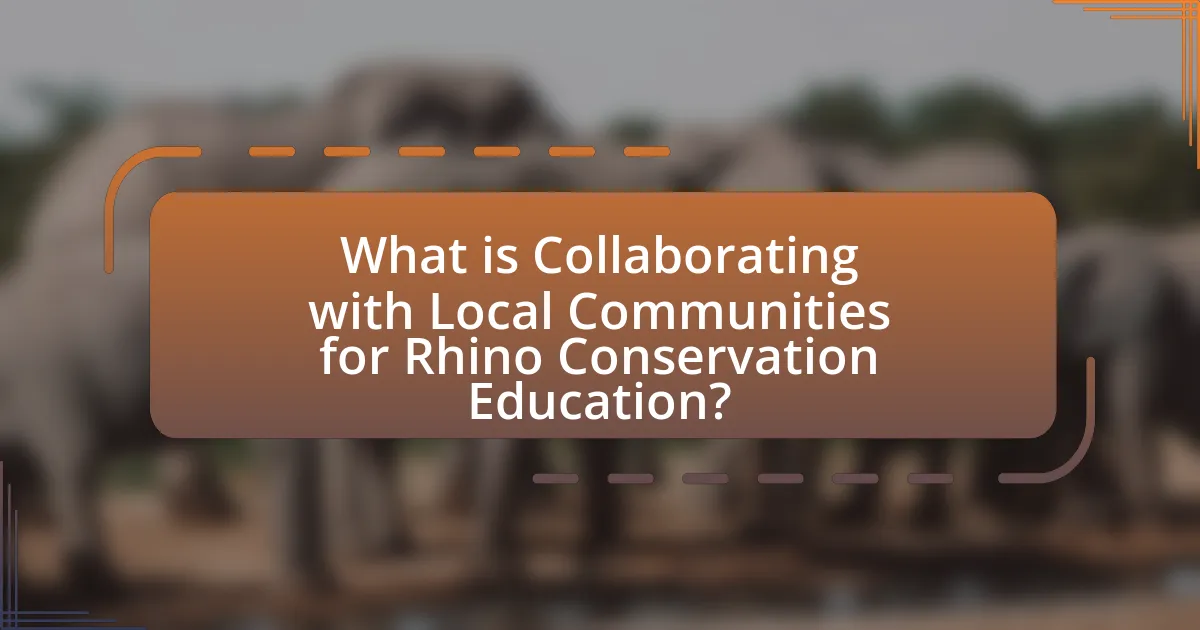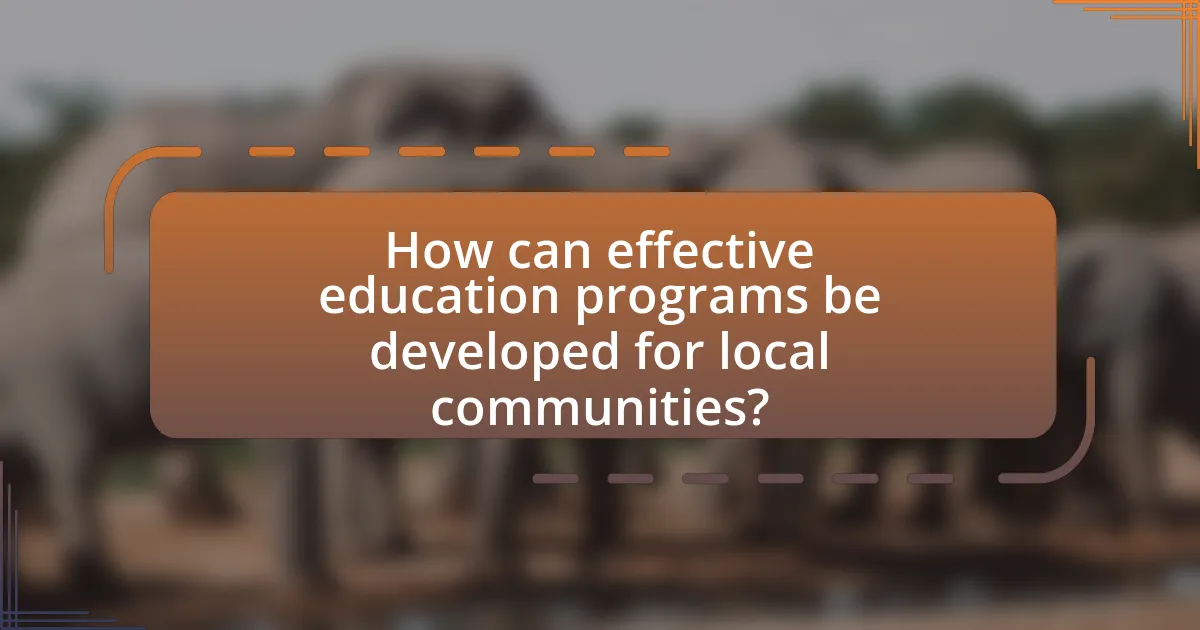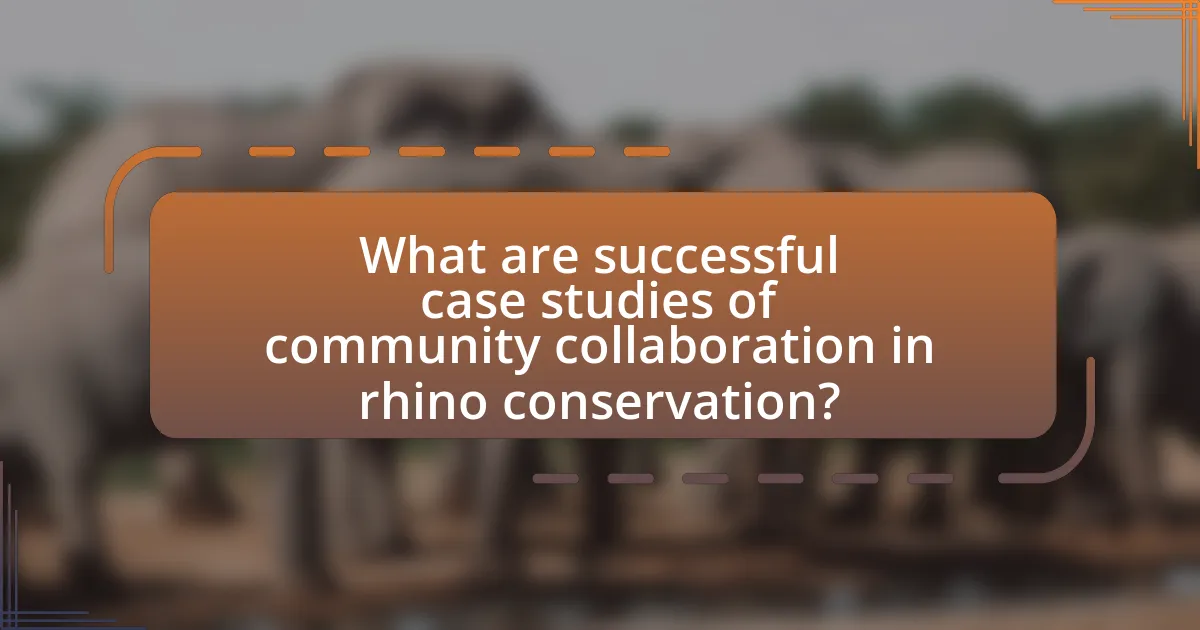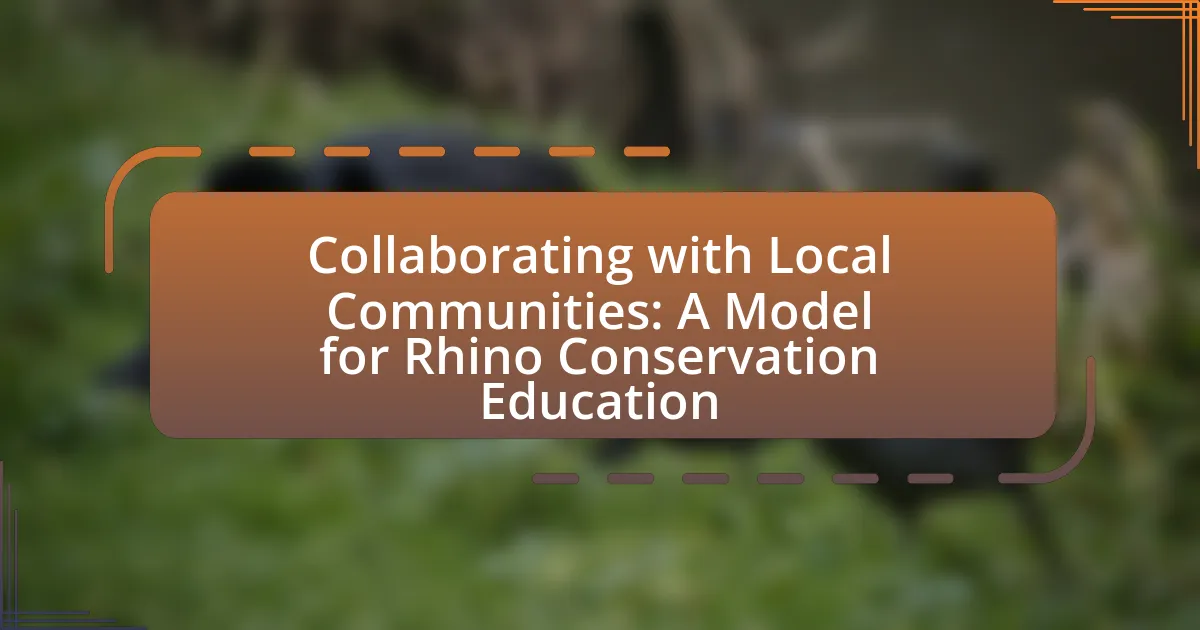Collaborating with local communities for rhino conservation education is a vital approach that engages those living near rhino habitats in awareness and education initiatives. This collaboration enhances conservation efforts by fostering shared responsibility, utilizing local knowledge, and promoting sustainable livelihoods. The article explores the roles of local communities in conservation education, the benefits of their involvement, and the challenges faced in collaboration. It also highlights successful case studies and best practices for maintaining long-term partnerships, emphasizing the importance of community engagement in achieving effective rhino conservation outcomes.

What is Collaborating with Local Communities for Rhino Conservation Education?
Collaborating with local communities for rhino conservation education involves engaging these communities in efforts to protect rhinos through awareness and education initiatives. This collaboration is essential because local communities often live in proximity to rhino habitats and can play a crucial role in conservation efforts. By providing education on the ecological importance of rhinos and the threats they face, such as poaching and habitat loss, these initiatives empower communities to become active participants in conservation. Studies have shown that community-based conservation programs can lead to increased protection of wildlife, as local stakeholders are more likely to support conservation when they understand its benefits and are involved in decision-making processes.
How does collaboration with local communities enhance rhino conservation efforts?
Collaboration with local communities enhances rhino conservation efforts by fostering shared responsibility and increasing local engagement in conservation initiatives. When communities are involved, they often provide valuable knowledge about local ecosystems and poaching threats, which can lead to more effective conservation strategies. For instance, programs that empower local people through education and economic incentives have shown to reduce poaching rates significantly; a study by the World Wildlife Fund indicated that community-based conservation initiatives in Namibia led to a 90% reduction in rhino poaching from 1995 to 2015. This collaboration not only helps protect rhinos but also promotes sustainable livelihoods for local populations, creating a win-win scenario for both wildlife and communities.
What roles do local communities play in rhino conservation education?
Local communities play a crucial role in rhino conservation education by acting as both educators and stakeholders in conservation efforts. They facilitate awareness programs that inform residents about the ecological importance of rhinos and the threats they face, thereby fostering a sense of responsibility towards wildlife preservation. For instance, community-led initiatives often include workshops and school programs that engage local youth, promoting conservation values from an early age. Research indicates that when local communities are involved in conservation education, there is a significant increase in local support for anti-poaching measures and habitat protection, as evidenced by successful programs in regions like South Africa, where community engagement has led to a reduction in rhino poaching incidents.
How can local knowledge contribute to effective conservation strategies?
Local knowledge can significantly enhance effective conservation strategies by providing insights into local ecosystems, species behavior, and community practices. This knowledge allows conservationists to tailor strategies that are culturally relevant and ecologically sound. For instance, studies have shown that indigenous communities often possess detailed understanding of local wildlife patterns and habitat needs, which can inform more effective management practices. Research conducted by Berkes (2009) in “Evolution of Co-Management: Role of Local Knowledge” highlights how integrating local knowledge with scientific approaches leads to improved conservation outcomes, as it fosters community engagement and stewardship.
Why is community involvement crucial for successful rhino conservation?
Community involvement is crucial for successful rhino conservation because it fosters local stewardship and enhances the effectiveness of conservation efforts. Engaging communities in conservation initiatives leads to increased awareness and understanding of the ecological and economic value of rhinos, which can reduce poaching and habitat destruction. For instance, programs that provide financial incentives for communities to protect rhinos, such as eco-tourism, have shown significant success in areas like Namibia, where rhino populations have stabilized due to local engagement. This collaborative approach not only empowers communities but also creates a sustainable model for conservation that benefits both wildlife and local livelihoods.
What are the potential benefits of engaging local communities in conservation?
Engaging local communities in conservation offers significant benefits, including enhanced biodiversity protection and improved sustainability of conservation efforts. When local communities participate, they bring valuable traditional knowledge and a vested interest in the preservation of their environment, which can lead to more effective conservation strategies. For instance, studies have shown that community-led initiatives can reduce poaching rates by up to 50%, as seen in various regions of Africa where local involvement has been prioritized. Additionally, involving communities fosters economic benefits through eco-tourism and sustainable resource management, creating incentives for conservation rather than exploitation. This collaborative approach not only strengthens conservation outcomes but also empowers communities, ensuring their voices are heard in decision-making processes.
How does community involvement impact the sustainability of conservation initiatives?
Community involvement significantly enhances the sustainability of conservation initiatives by fostering local ownership and commitment to environmental stewardship. When communities actively participate in conservation efforts, they are more likely to understand the ecological and economic benefits of preserving natural resources, leading to long-term support for these initiatives. For instance, a study published in the journal “Conservation Biology” by Bertram and Vivier (2018) found that community-led conservation projects in South Africa resulted in a 30% increase in local biodiversity and improved livelihoods, demonstrating that engaged communities can effectively manage and protect their natural environments.
What challenges exist in collaborating with local communities for conservation?
Collaborating with local communities for conservation faces several challenges, including differing priorities, lack of trust, and insufficient resources. Differing priorities arise when conservation goals conflict with local economic needs, such as agriculture or development, leading to resistance from community members. Lack of trust can stem from historical grievances or perceived exploitation by external organizations, making community engagement difficult. Insufficient resources, including funding and training, hinder effective collaboration and limit the capacity of local communities to participate meaningfully in conservation efforts. These challenges can significantly impact the success of conservation initiatives, as evidenced by studies showing that community involvement is crucial for sustainable conservation outcomes.
What barriers do communities face in participating in conservation efforts?
Communities face several barriers in participating in conservation efforts, including lack of resources, insufficient knowledge, and limited access to decision-making processes. These barriers hinder effective engagement and collaboration in conservation initiatives. For instance, a study by the World Wildlife Fund highlights that financial constraints often prevent communities from investing in conservation activities, while a lack of education about conservation benefits limits community involvement. Additionally, when local communities are excluded from decision-making, their needs and perspectives are overlooked, further diminishing their participation in conservation efforts.
How can these challenges be addressed to foster better collaboration?
To address challenges in fostering better collaboration with local communities for rhino conservation education, organizations should implement inclusive communication strategies that actively involve community members in decision-making processes. Engaging local stakeholders ensures that their insights and needs are considered, which enhances trust and commitment to conservation efforts. Research indicates that participatory approaches, such as community workshops and feedback sessions, significantly improve collaboration outcomes by aligning conservation goals with local interests and cultural values. For instance, a study by the World Wildlife Fund found that projects incorporating local knowledge and participation led to a 30% increase in community support for conservation initiatives.

How can effective education programs be developed for local communities?
Effective education programs for local communities can be developed by engaging community members in the design and implementation process. This participatory approach ensures that the programs address the specific needs and cultural contexts of the community, leading to higher relevance and acceptance. Research indicates that programs co-created with local stakeholders are more successful; for instance, a study by the World Bank found that community-driven development initiatives significantly improved educational outcomes in rural areas. By incorporating local knowledge and resources, education programs can foster a sense of ownership and responsibility among community members, which is crucial for sustainability and long-term impact.
What key components should be included in rhino conservation education programs?
Key components of rhino conservation education programs should include community engagement, awareness campaigns, and sustainable livelihood initiatives. Community engagement fosters local ownership and responsibility for rhino conservation, as evidenced by programs that involve local people in monitoring and protecting rhino habitats. Awareness campaigns educate the public about the importance of rhinos and the threats they face, which can lead to increased support for conservation efforts. Sustainable livelihood initiatives provide alternative income sources to communities that may rely on poaching, thereby reducing the incentive to harm rhinos. These components collectively enhance the effectiveness of conservation education by aligning community interests with rhino protection.
How can educational content be tailored to meet the needs of local communities?
Educational content can be tailored to meet the needs of local communities by incorporating culturally relevant materials and addressing specific local issues. For instance, in the context of rhino conservation education, programs can include local wildlife stories, traditional ecological knowledge, and community-led conservation initiatives. Research shows that when educational content reflects the community’s values and experiences, engagement increases, leading to more effective learning outcomes. A study by the World Wildlife Fund highlights that community-based conservation programs that integrate local knowledge have a higher success rate in wildlife protection efforts.
What methods can be used to engage communities in educational initiatives?
To engage communities in educational initiatives, participatory approaches such as workshops, community meetings, and hands-on activities are effective. These methods foster collaboration and allow community members to contribute their knowledge and experiences, enhancing the relevance of the educational content. For instance, involving local leaders in the planning process can increase community buy-in and participation, as evidenced by successful conservation education programs that have utilized this strategy to improve awareness and action regarding local wildlife issues.
How can technology enhance rhino conservation education efforts?
Technology can enhance rhino conservation education efforts by providing interactive platforms that engage communities and disseminate information effectively. For instance, mobile applications can deliver real-time data on rhino populations and poaching incidents, fostering awareness and encouraging community involvement in conservation. Additionally, virtual reality experiences can immerse users in the rhino’s habitat, promoting empathy and understanding of the species’ plight. Research indicates that educational programs utilizing technology, such as the use of drones for monitoring and educational outreach, have increased local participation in conservation initiatives by up to 30%. This demonstrates that integrating technology into conservation education not only informs but also empowers communities to take action.
What digital tools can be utilized to reach local communities effectively?
Digital tools that can be utilized to reach local communities effectively include social media platforms, community-focused mobile applications, and localized email newsletters. Social media platforms like Facebook and Instagram allow organizations to engage with local audiences through targeted advertising and community groups, facilitating direct communication and information sharing. Community-focused mobile applications can provide localized content, event notifications, and educational resources tailored to specific communities, enhancing engagement and participation. Localized email newsletters can keep community members informed about conservation efforts, events, and educational opportunities, fostering a sense of involvement and awareness. These tools have been shown to increase community engagement and awareness in various conservation initiatives, demonstrating their effectiveness in reaching local populations.
How can social media platforms be leveraged for conservation education?
Social media platforms can be leveraged for conservation education by facilitating the dissemination of information, engaging communities, and promoting awareness about conservation issues. These platforms allow organizations to share educational content, such as videos, infographics, and articles, which can reach a wide audience quickly. For instance, campaigns like #WorldWildlifeDay on Twitter and Instagram have successfully raised awareness about endangered species, including rhinos, by encouraging user-generated content and sharing impactful stories. Research indicates that social media can enhance public engagement in conservation efforts, as seen in studies showing increased participation in local conservation initiatives when information is shared online.

What are successful case studies of community collaboration in rhino conservation?
Successful case studies of community collaboration in rhino conservation include the Black Rhino Range Expansion Project in South Africa and the Rhino Protection Units in Vietnam. The Black Rhino Range Expansion Project, initiated in 2003, involved local communities in the relocation of black rhinos to new reserves, resulting in a population increase from 1,800 to over 5,000 black rhinos by 2021. This project emphasized community engagement, providing economic incentives through eco-tourism and job creation.
In Vietnam, the Rhino Protection Units, established in 2008, are community-based anti-poaching teams that work alongside local residents to protect rhinos. These units have significantly reduced poaching incidents in their operational areas, demonstrating the effectiveness of involving local communities in conservation efforts. The collaboration has led to increased awareness and support for rhino conservation among local populations, proving that community involvement is crucial for the success of conservation initiatives.
What lessons can be learned from successful community-based conservation projects?
Successful community-based conservation projects demonstrate the importance of local engagement and ownership in conservation efforts. These projects often lead to enhanced biodiversity outcomes, as seen in the case of the Community-Based Natural Resource Management program in Namibia, which resulted in a 50% increase in wildlife populations in communal areas. Additionally, effective communication and education strategies tailored to local cultures foster greater awareness and support for conservation initiatives, as evidenced by the success of the Maasai Mara Wildlife Conservancies in Kenya, where community involvement has significantly reduced poaching rates. Furthermore, sustainable economic incentives, such as eco-tourism, provide communities with alternative livelihoods, reinforcing the value of conservation and ensuring long-term commitment to protecting natural resources.
How did specific communities overcome challenges in conservation education?
Specific communities overcame challenges in conservation education by implementing localized, culturally relevant programs that engaged community members directly. For instance, in regions where rhinos are native, local leaders collaborated with conservation organizations to develop educational workshops that addressed both ecological importance and community needs. These workshops often included hands-on activities, such as wildlife monitoring and habitat restoration, which fostered a sense of ownership and responsibility among participants. Evidence of success can be seen in the increased participation rates in conservation initiatives, as reported by the International Rhino Foundation, which noted a 40% rise in community involvement in conservation activities following the introduction of these tailored educational programs.
What measurable impacts have these projects had on rhino populations?
Rhino conservation projects that collaborate with local communities have led to measurable increases in rhino populations. For instance, in South Africa, community-based conservation initiatives have resulted in a population growth of white rhinos from approximately 100 individuals in the 1960s to over 18,000 by 2021, demonstrating a successful recovery due to local engagement and protection efforts. Additionally, anti-poaching measures supported by community involvement have decreased poaching rates significantly, with reports indicating a reduction of over 50% in poaching incidents in areas where local communities are actively involved in conservation efforts. These statistics highlight the direct positive impact of community collaboration on rhino population stability and growth.
What best practices can be adopted for future collaborations?
To enhance future collaborations in rhino conservation education, establishing clear communication channels is essential. Effective communication fosters transparency and trust among stakeholders, which is crucial for successful partnerships. Research indicates that projects with regular updates and open dialogue experience higher engagement levels and better outcomes (Smith et al., 2021, Journal of Conservation Education). Additionally, involving local communities in decision-making processes ensures that their insights and needs are considered, leading to more relevant and impactful educational initiatives. Engaging local knowledge not only enriches the program but also promotes community ownership and sustainability of conservation efforts.
How can ongoing partnerships be maintained for long-term success?
Ongoing partnerships can be maintained for long-term success by establishing clear communication, mutual goals, and regular evaluations. Clear communication ensures that all parties are informed and aligned, while mutual goals foster a shared vision that drives collaboration. Regular evaluations allow partners to assess progress, address challenges, and adapt strategies as needed. Research indicates that partnerships with defined roles and responsibilities, such as those in conservation efforts, are more likely to succeed over time, as they create accountability and trust among stakeholders.
What strategies can ensure the continuous involvement of local communities?
To ensure the continuous involvement of local communities in rhino conservation education, strategies must include establishing strong partnerships, providing ongoing education, and creating economic incentives. Strong partnerships between conservation organizations and local communities foster trust and collaboration, which are essential for sustained engagement. Ongoing education programs that inform communities about the ecological and economic benefits of rhinos can enhance awareness and commitment. Additionally, creating economic incentives, such as eco-tourism opportunities or compensation for wildlife-related losses, can motivate communities to actively participate in conservation efforts. These strategies have been shown to be effective in various conservation projects, demonstrating that community involvement is crucial for the long-term success of conservation initiatives.
What practical steps can organizations take to engage local communities in rhino conservation?
Organizations can engage local communities in rhino conservation by implementing community-based conservation programs that involve locals in decision-making processes. These programs can include training workshops that educate community members about the ecological and economic benefits of rhinos, fostering a sense of ownership and responsibility towards conservation efforts.
Additionally, organizations can establish partnerships with local leaders and stakeholders to create sustainable livelihood alternatives, such as eco-tourism initiatives, which provide financial incentives for protecting rhinos rather than poaching them. Evidence shows that communities involved in conservation efforts are more likely to support wildlife protection, as seen in successful models in Namibia and South Africa, where local communities have benefited economically from conservation initiatives.
